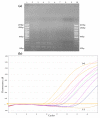Evaluation of Five Non-Culture-Based Methods for the Diagnosis of Meningeal Sporotrichosis
- PMID: 37233246
- PMCID: PMC10219554
- DOI: 10.3390/jof9050535
Evaluation of Five Non-Culture-Based Methods for the Diagnosis of Meningeal Sporotrichosis
Abstract
Sporotrichosis is the main subcutaneous mycosis worldwide. Several complications, including meningeal forms, can be observed in immunocompromised individuals. The sporotrichosis diagnosis is time-consuming due to the culture's limitations. The low fungal burden in cerebrospinal fluid (CSF) samples is another important drawback in the diagnosis of meningeal sporotrichosis. Molecular and immunological tests can improve the detection of Sporothrix spp. in clinical specimens. Therefore, the following five non-culture-based methods were evaluated for the detection of Sporothrix spp. in 30 CSF samples: (i) species-specific polymerase chain reaction (PCR); (ii) nested PCR; (iii) quantitative PCR; (iv) enzyme-linked immunosorbent assay (ELISA) for IgG detection; and (v) ELISA for IgM detection. The species-specific PCR was unsuccessful in the diagnosis of the meningeal sporotrichosis. The other four methods presented substantial levels of sensitivity (78.6% to 92.9%) and specificity (75% to 100%) for the indirect detection of Sporothrix spp. Both DNA-based methods presented similar accuracy (84.6%). Both ELISA methods were concomitantly positive only for patients with sporotrichosis and clinical signs of meningitis. We suggest that these methods should be implemented in clinical practice to detect Sporothrix spp. in CSF early, which may optimize treatment, augment the chances of a cure, and improve the prognosis of affected individuals.
Keywords: ELISA; Sporothrix; cerebrospinal fluid; immunological diagnosis; molecular diagnosis; qPCR.
Conflict of interest statement
The authors declare no conflict of interest.
Figures


Similar articles
-
Development and validation of a new quantitative reverse transcription PCR assay for the diagnosis of human sporotrichosis.Med Mycol. 2023 Jul 6;61(7):myad063. doi: 10.1093/mmy/myad063. Med Mycol. 2023. PMID: 37491705
-
Detection of Sporothrix schenckii in clinical samples by a nested PCR assay.J Clin Microbiol. 2003 Apr;41(4):1414-8. doi: 10.1128/JCM.41.4.1414-1418.2003. J Clin Microbiol. 2003. PMID: 12682123 Free PMC article.
-
Immunoglobulins G, M, and A against Sporothrix schenckii exoantigens in patients with sporotrichosis before and during treatment with itraconazole.Clin Vaccine Immunol. 2007 Sep;14(9):1149-57. doi: 10.1128/CVI.00149-07. Epub 2007 Jul 18. Clin Vaccine Immunol. 2007. PMID: 17634504 Free PMC article.
-
Molecular identification of the Sporothrix schenckii complex.Rev Iberoam Micol. 2014 Jan-Mar;31(1):2-6. doi: 10.1016/j.riam.2013.09.008. Epub 2013 Nov 19. Rev Iberoam Micol. 2014. PMID: 24270070 Review.
-
Trends in Molecular Diagnostics and Genotyping Tools Applied for Emerging Sporothrix Species.J Fungi (Basel). 2022 Jul 31;8(8):809. doi: 10.3390/jof8080809. J Fungi (Basel). 2022. PMID: 36012797 Free PMC article. Review.
Cited by
-
Molecular diagnostics in cerebrospinal fluid for the diagnosis of central nervous system infections.Clin Microbiol Rev. 2024 Dec 10;37(4):e0002124. doi: 10.1128/cmr.00021-24. Epub 2024 Oct 15. Clin Microbiol Rev. 2024. PMID: 39404267 Review.
-
Extracutaneous sporotrichosis.Clin Microbiol Rev. 2025 Mar 13;38(1):e0014024. doi: 10.1128/cmr.00140-24. Epub 2025 Jan 14. Clin Microbiol Rev. 2025. PMID: 39807894 Review.
-
The present and future research agenda of sporotrichosis on the silver anniversary of zoonotic sporotrichosis in Rio de Janeiro, Brazil.Mem Inst Oswaldo Cruz. 2024 Feb 12;119:e230208. doi: 10.1590/0074-02760230208. eCollection 2024. Mem Inst Oswaldo Cruz. 2024. PMID: 38359307 Free PMC article.
-
Meningeal sporotrichosis in an immunocompetent host: A case report.Med Mycol Case Rep. 2024 Aug 28;45:100665. doi: 10.1016/j.mmcr.2024.100665. eCollection 2024 Sep. Med Mycol Case Rep. 2024. PMID: 39290785 Free PMC article.
-
A novel approach for feline sporotrichosis pathogen detection based on loop-mediated isothermal amplification.Vet Dermatol. 2025 Aug;36(4):474-484. doi: 10.1111/vde.13345. Epub 2025 Apr 21. Vet Dermatol. 2025. PMID: 40259669 Free PMC article.
References
-
- De Macedo P.M., Falcão E.M.M., Freitas D.F.S., Freitas A.d., Coutinho Z.F., Muniz M.d.M., Zancopé-Oliveira R.M., Almeida-Paes R., da Silva M.T.T., do Valle A.C.F. Neuroparacoccidioidomycosis: A 13-Year cohort study, Rio de Janeiro, Brazil. J. Fungi. 2020;6:303. doi: 10.3390/jof6040303. - DOI - PMC - PubMed
Grants and funding
- INI-003-FIO-19-2-13/Programa Jovens Pesquisadores - INI/FIOCRUZ
- 405653/2021-2/National Council for Scientific and Technological Development
- 403296/2021-8/National Council for Scientific and Technological Development
- 308315/2021-9/National Council for Scientific and Technological Development
- E-26/200.381/2023/Fundação Carlos Chagas Filho de Amparo à Pesquisa do Estado do Rio de Janeiro
LinkOut - more resources
Full Text Sources
Miscellaneous

